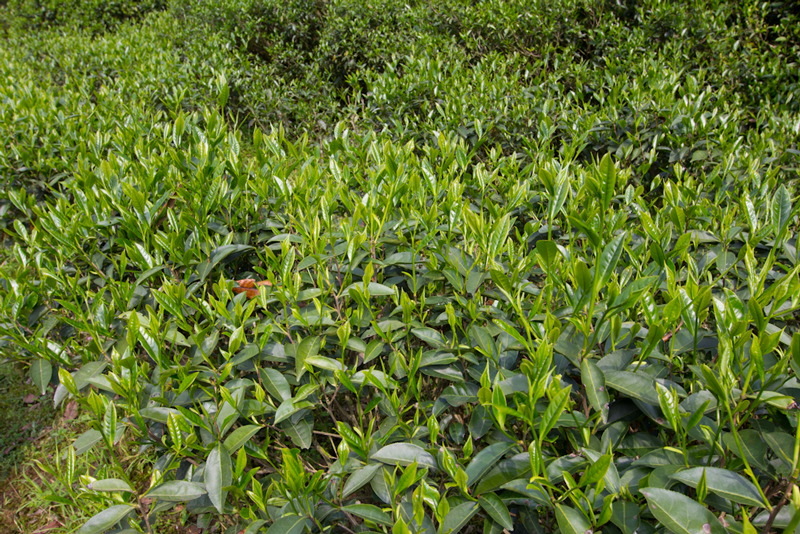What kind of tea does Phoenix Dancong belong to? is Dancong tea an authentic brand of cold or warm?
Making Phoenix Dancong Oolong Tea
Withering
After picking, take the fresh tea back to the factory and lay it on a bamboo mat with a thickness of about 10 centimeters. Then move the bamboo mat outside and wither the tea leaves in the sun at about 4-5 p.m. Then spread the leaves thinly to about 3 centimeters, they should not overlap each other. In general, the time at which leaves wither depends on atmospheric temperature:
At 22-28 degrees, it takes 15-20 minutes.
When the temperature is about 20-25 degrees Celsius, it takes 20-30 minutes.
If the temperature is close to 28-33 degrees, it will take about 10 minutes
The actual withering time is also affected by the water content of fresh tea. During the withering period, the tea leaves are not turned to avoid any damage to the tea leaves.
Signs of completion of the withering process:
The buds bent down
The leaves become soft and give off a fresh green
The color of the leaves changed from bright green to dim color. By this time, the leaves have lost about 10-15% of their moisture.
The second stage of cooling-withering
After withering in the sun, the tea is transferred to a cool place indoors and let it cool for about 1-2 hours. The purpose of this process is to cause further wilting to occur under colder conditions. Collect the sun-dried leaves and adjust the thickness of the expanded leaves according to atmospheric conditions. For example, in windy seasons, the thickness increases to prevent excessive loss of water from leaves.

During this period, the biochemical reaction occurred slowly, which increased the by-products of hydrolysis in leaves, enhanced the permeability of cell wall and increased the activity of enzymes, such as enzyme polyphenol oxidase (PPO).
Ferment
This process is also known as Peng-qing, or Lang-cha is the most critical process in Phoenix tea. It is manually operated to induce damage to the edge of the leaf, which will damage the cell wall. Polyphenol oxidase reacts with the substrate to form the taste, taste and color of tea. In addition, the atmospheric temperature required for oxidation to occur is about 22-28 degrees Celsius, and the relative humidity is about 75-85%, starting from 6-7 p.m., lasting about 10-12 hours until the next morning.
Bamboo boards with a diameter of 130 cm, a depth of about 28 cm and an opening size of about 0.5 cm × 0.5 cm are generally selected and hung indoors. There are about 5-6 kilograms of leaves in each bamboo tray, and two workers stand in the opposite direction with bamboo trays. Next, shake up and down 15 times to make the leaves wavy. Then, collect the leaves and place the concave words on the bamboo plate for 2 hours until the next process. Repeat the second and third times, shake 30 and 45 times, respectively, and let the leaves stand for 2 hours. Repeat this process 4, 5, 6 times (sometimes up to 7 times), placing 25-30 kg of leaves in a bamboo tube with a length of 200 cm, an entrance of 75 cm and an opening of 0.6 cm × 0.6 cm. The drum rotates at different times: the fourth 5 minutes, the remaining 2.5 hours, and then 10 minutes. For the fifth time, leave the leaves inside for 2.5 hours, and for the sixth time, rotate the leaves for 20 minutes and place them for 1-2 hours.
The test of oxidation degree is mainly based on the changes of flavor, shape and color of tobacco leaves. In this process, the leaves of the first and second stages have no smell of grass, but give off fresh green. After 3 or 4 times of oxidation, the fresh green flavor will gradually become thicker, with a touch of sweet and greasy sweetness. In the 5th and 6th stages of oxidation, the taste of fresh green will fade, but it will produce more fruity and floral flavors. To sum up, the complete oxidation process shows that:
The edge of the leaf turns red, while the central part remains green. Usually, the ratio of red to green on a leaf is 20:80 or 30:70.
Leaf veins become translucent
The leaves are bent like a spoon
The leaves give off the scent of flowers or fruit.
At this time, the water content of the leaf is about 68%. Then gather the leaves together and fry them in a pan for an hour.
Important Notice :
前街咖啡 FrontStreet Coffee has moved to new addredd:
FrontStreet Coffee Address: 315,Donghua East Road,GuangZhou
Tel:020 38364473
- Prev

What coffee beans are good for iced lattes? Iced latte practice course hand-in-hand teaching
Iced latte seems to be a very simple way, [pour milk with ice to pour coffee] is completed, seemingly simple operation, to make a good iced latte also takes a lot of mental understanding. The first point: choose the right material why ice latte is so simple, basically every coffee bean menu is necessary, but each family's iced latte taste will not be exactly the same.
- Next
What kind of fragrance is the fragrance of Phoenix duck poop? What is the difference between the characteristics of Phoenix single cluster and Wushu single cluster?
Boiling-preliminary forming in the process of frying, high temperature and short-term heating treatment will instantly inactivate the enzyme and prevent oxidation for a long time, thus stabilizing the quality and characteristics of fermented tea. Deep frying and rolling take turns, repeating twice to form a shape. In the first stage, when the temperature of the pot reaches 140-160 degrees Celsius, put 1-2 kilograms of leaves into the pan and fry for 4-5 minutes.
Related
- Beginners will see the "Coffee pull flower" guide!
- What is the difference between ice blog purified milk and ordinary milk coffee?
- Why is the Philippines the largest producer of crops in Liberia?
- For coffee extraction, should the fine powder be retained?
- How does extracted espresso fill pressed powder? How much strength does it take to press the powder?
- How to make jasmine cold extract coffee? Is the jasmine + latte good?
- Will this little toy really make the coffee taste better? How does Lily Drip affect coffee extraction?
- Will the action of slapping the filter cup also affect coffee extraction?
- What's the difference between powder-to-water ratio and powder-to-liquid ratio?
- What is the Ethiopian local species? What does it have to do with Heirloom native species?

